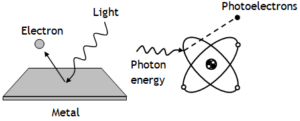^Photoelectric effect
^Photoelectric effect
1. An instantaneous process (10-8 s) of emission of free electrons from the surface of a metal (also called cathode) when light photons of energy greater than threshold frequency are incident on it.

2. Einstein experimentally confirmed that the Photoelectric effect is a one-photon-one electron process & verifies the quantum nature of light as it is the result of particle-particle interaction.
3. Threshold energy (or work function) is the least energy required by an electron to come out of the metal. Its value is few eV & it depends only on the nature of metallic surface & impurities present in it & is independent of the energy or incident photons. W = W0 = E th = hf th.
4. Alkali metals like Li, Na, K, Cs, Rb etc. show PEE with visible light. Metals like Zn, Cd, Mn etc. are sensitive only to UV-light. Cs (Cesium) is the best photosensitive metal.
